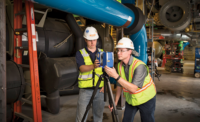
Professors from several colleges have joined forces to create the world's first plasmofluidic lens—a tiny water bubble used to manipulate and focus a beam of light at the nanoscale. Researchers say it could open doors to develop smaller, faster electronic circuitry.
To make the lens, a low-intensity laser heats water on a gold-film surface, creating a water bubble, says Yongmin Liu, assistant professor in the mechanical and industrial engineering department and the electrical and computer engineering department at Northeastern University, Boston. The bubble's optical behavior remains consistent as long as the laser's power and the ambient temperature stay constant, says Liu. The way the bubble refracts light is controlled by adjusting the laser's power. To work with light at the nanoscale, professors from Northeastern University, Penn State and MIT used nanoplasmonics to overcome a limiting challenge called the "diffraction limit" of light.
The team of professors wanted to work in a liquid environment so they could configure the bubble lenses as needed, says Liu.
The main benefit of the bubble lens is its ability to change size and shape easily, says Liu. The next step is to find out how the bubble's shape influences the direction of the light beam and location of its focal point. The ability to control light beams minutely could improve on-chip biomedical devices and super-resolution imaging.



Post a comment to this article
Report Abusive Comment